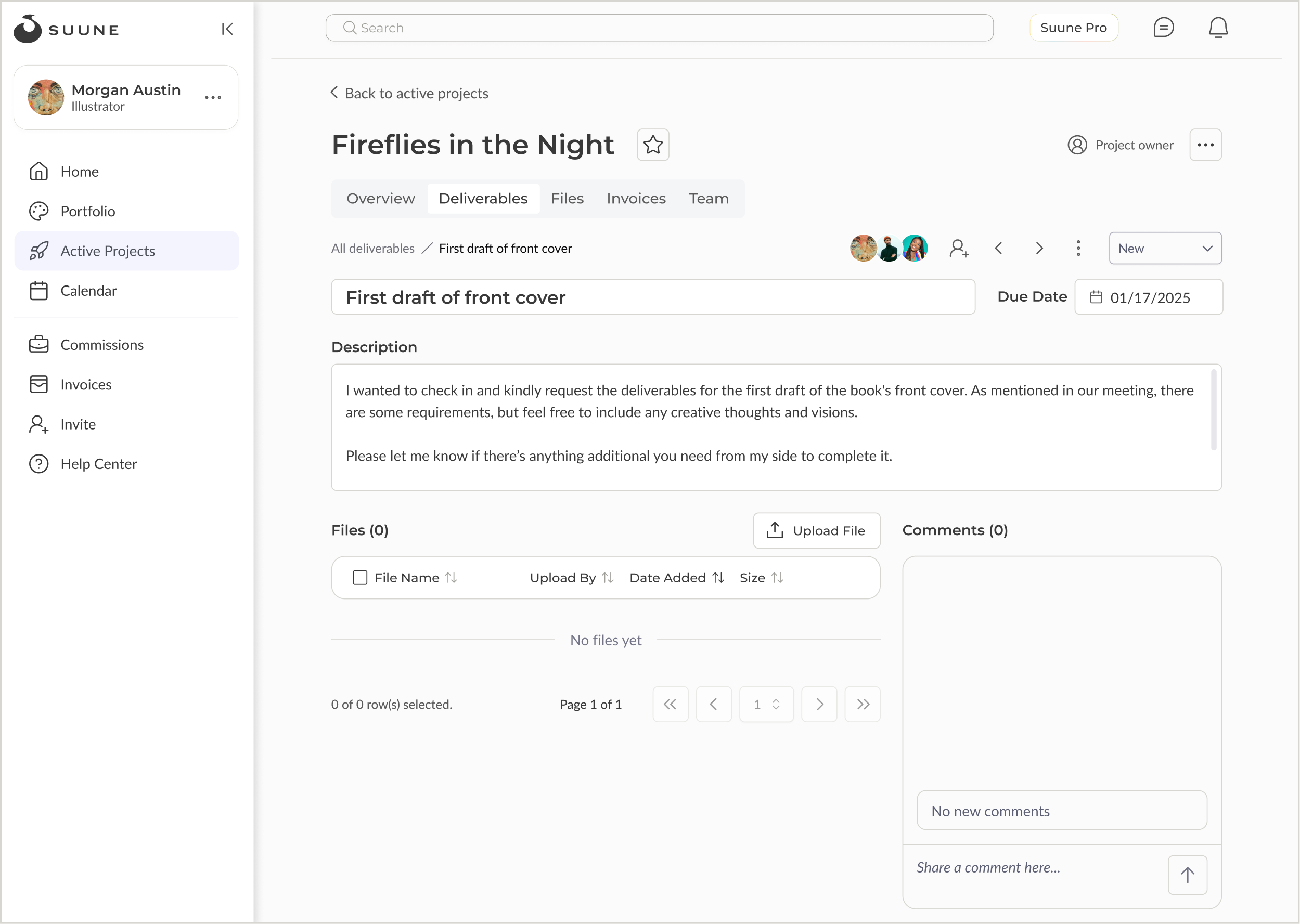Task Management SaaS
A Smooth Workflow for Freelance Visual Artists
My Role
Product Designer (UI/UX, Wireframes, Prototyping)
Impact
Accessibility: +19%
User satisfaction: +14%
Task error rates: -6%
Timeline
Jan 2025 - Mar 2025
What Is the Project About
Suune is a project management SaaS designed to help freelance visual artists manage commission-based work. Leveraging the chosen API and open source design system, I led design decisions to improve task visibility, file handoff, and communication between artists and clients.
Problem
The original interface was unclear and inaccessible, making it hard for freelance artists to manage tasks and stay organized across multiple projects.
Goal
Seamless management: View tasks, upload and manage files with ease.
Clear task tracking with progress updates: artists can know what needs to be done, by whom, when, and which stage each task is in.
My Responsibility and Process
As the product designer, I was responsible for reshaping the interface and user flow for better usability—focusing on deliverable management. I also enforced applying the design system to maintain consistency across platform and collaborated closely with developers to assess feasibility and simplify implementation.
Final Impact
Accessibility improved by 19%
User satisfaction increased by 14%
Task flow error rates dropped by 6%
Project Scope and Limitations
The initial MVP for deliverable management includes:
Required: upload files, comment section, invite member, deliverable creation, details and stages
Good to haves: filters, sorting, pin items, show active profile
More useful features are under considerations for future developmentConsistency across various devices (though we initially focused on mobile)
Many features were designed with development feasibility in mind due to limitations from API for backend and design system for frontend
Primarily a web app for desktop
The original interface was inaccessible and cluttered, making it hard for freelance artists to manage tasks and collaborate efficiently.
😵💫
Before I joined, the initial interface was unclear, cluttered and inaccessible, making it difficult for users to manage tasks efficiently. Elements like task lists, file uploads, and project details were crammed into a single screen, resulting in cognitive overload and poor task visibility. Since our users are freelance artists balancing multiple commissions, the tool needed to be simple, intuitive, and easy to navigate.
Users Struggled with Accessibility Issues and Cognitive Overload
To understand current user pain points, I conducted some initial testings with potential users and analyzed the insights and main struggles that hurt the user experience.
Unclear Call-to-actions
Confusing project status and deliverable stage
Tiny fonts (mostly between 11-13px)
Certain elements lacks color contrast
Various sections in one screen cause cognitive overload
Process Leading to a Clear and Accessible Solution
UI Consistency + Accessibility
While the team was using a design system, it wasn’t consistently implemented. Through meetings and collaborations, I led the team to unify UI elements across the platform. I also ensured the designs were accessible, maintaining WCAG-compliant contrast ratio.
Layout Explorations + Iterations
With the testing insights, I was able to explore potential solutions for a clear layout, improving user experience:
Original: cluttered with all information on one screen
Final: moved the task list to a separate screen and introduced a bento-style layout, giving more space to key content. This helps artists focus on one section at a time without losing context or feeling overwhelmed.
Advocated Auto-Save Feature and Status Placement for Intuitive User Flows
Auto-Save Feature
To improve user flow and reduce friction, I advocated the auto-save feature by working closely with the dev team, so users don’t need to keep clicking save button when making changes in deliverable detail page.
Status Placement
The project status is removed to be only shown in the “Overview” page, avoiding distraction and confusion with the deliverable stages in the detail page.
Final Design Preview
What I Learned
This project reinforced the importance of close collaboration with engineers. Understanding technical constraints early helped us balance user experience with development feasibility—like when we worked together to implement auto-save instead of relying on manual save buttons.
What’s Next
Design onboarding tutorials for first-time users
Add tooltips to improve clarity for icons and actions
Plan on designing the mobile version
More Projects
Next Project ❯
Avis App
Unsolicited redesign to explore a hassle-free car rental journey
❮ Previous Project
WUA: Design System
Design an accessible system














